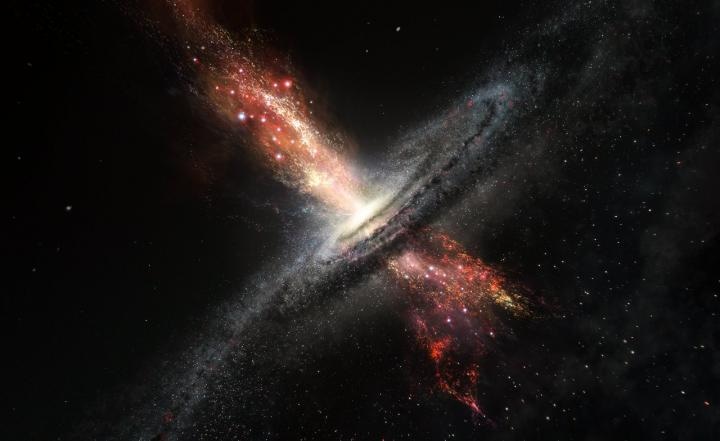Mar 28 2017
A UK-led group of European astronomers used the MUSE and X-shooter instruments on the Very Large Telescope (VLT) at ESO’s Paranal Observatory in Chile to study an ongoing collision between two galaxies, known collectively as IRAS F23128-5919, that lie around 600 million light-years from Earth. The group observed the colossal winds of material — or outflows — that originate near the supermassive black hole at the heart of the pair’s southern galaxy, and have found the first clear evidence that stars are being born within them [1].
 Artist's impression of a galaxy forming stars within powerful outflows of material blasted out from supermassive black holes at its core. Results from ESO's Very Large Telescope are the first confirmed observations of stars forming in this kind of extreme environment. The discovery has many consequences for understanding galaxy properties and evolution. (Credit: ESO/M. Kornmesser)
Artist's impression of a galaxy forming stars within powerful outflows of material blasted out from supermassive black holes at its core. Results from ESO's Very Large Telescope are the first confirmed observations of stars forming in this kind of extreme environment. The discovery has many consequences for understanding galaxy properties and evolution. (Credit: ESO/M. Kornmesser)
Such galactic outflows are driven by the huge energy output from the active and turbulent centres of galaxies. Supermassive black holes lurk in the cores of most galaxies, and when they gobble up matter they also heat the surrounding gas and expel it from the host galaxy in powerful, dense winds [2].
“Astronomers have thought for a while that conditions within these outflows could be right for star formation, but no one has seen it actually happening as it’s a very difficult observation,” comments team leader Roberto Maiolino from the University of Cambridge. “Our results are exciting because they show unambiguously that stars are being created inside these outflows.”
The group set out to study stars in the outflow directly, as well as the gas that surrounds them. By using two of the world-leading VLT spectroscopic instruments, MUSE and X-shooter, they could carry out a very detailed study of the properties of the emitted light to determine its source.
Radiation from young stars is known to cause nearby gas clouds to glow in a particular way. The extreme sensitivity of X-shooter allowed the team to rule out other possible causes of this illumination, including gas shocks or the active nucleus of the galaxy.
The group then made an unmistakable direct detection of an infant stellar population in the outflow [3]. These stars are thought to be less than a few tens of millions of years old, and preliminary analysis suggests that they are hotter and brighter than stars formed in less extreme environments such as the galactic disc.
As further evidence, the astronomers also determined the motion and velocity of these stars. The light from most of the region’s stars indicates that they are travelling at very large velocities away from the galaxy centre — as would make sense for objects caught in a stream of fast-moving material.
Co-author Helen Russell (Institute of Astronomy, Cambridge, UK) expands: “The stars that form in the wind close to the galaxy centre might slow down and even start heading back inwards, but the stars that form further out in the flow experience less deceleration and can even fly off out of the galaxy altogether.”
The discovery provides new and exciting information that could better our understanding of some astrophysics, including how certain galaxies obtain their shapes [4]; how intergalactic space becomes enriched with heavy elements [5]; and even from where unexplained cosmic infrared background radiation may arise [6].
Maiolino is excited for the future: “If star formation is really occurring in most galactic outflows, as some theories predict, then this would provide a completely new scenario for our understanding of galaxy evolution.”
Notes
[1] Stars are forming in the outflows at a very rapid rate; the astronomers say that stars totalling around 30 times the mass of the Sun are being created every year. This accounts for over a quarter of the total star formation in the entire merging galaxy system.
[2] The expulsion of gas through galactic outflows leads to a gas-poor environment within the galaxy, which could be why some galaxies cease forming new stars as they age. Although these outflows are most likely to be driven by massive central black holes, it is also possible that the winds are powered by supernovae in a starburst nucleus undergoing vigorous star formation.
[3] This was achieved through the detection of signatures characteristic of young stellar populations and with a velocity pattern consistent with that expected from stars formed at high velocity in the outflow.
[4] Spiral galaxies have an obvious disc structure, with a distended bulge of stars in the centre and surrounded by a diffuse cloud of stars called a halo. Elliptical galaxies are composed mostly of these spheroidal components. Outflow stars that are ejected from the main disc could give rise to these galactic features.
[5] How the space between galaxies — the intergalactic medium — becomes enriched with heavy elements is still an open issue, but outflow stars could provide an answer. If they are jettisoned out of the galaxy and then explode as supernovae, the heavy elements they contain could be released into this medium.
[6] Cosmic-infrared background radiation, similar to the more famous cosmic microwave background, is a faint glow in the infrared part of the spectrum that appears to come from all directions in space. Its origin in the near-infrared bands, however, has never been satisfactorily ascertained. A population of outflow stars shot out into intergalactic space may contribute to this light.